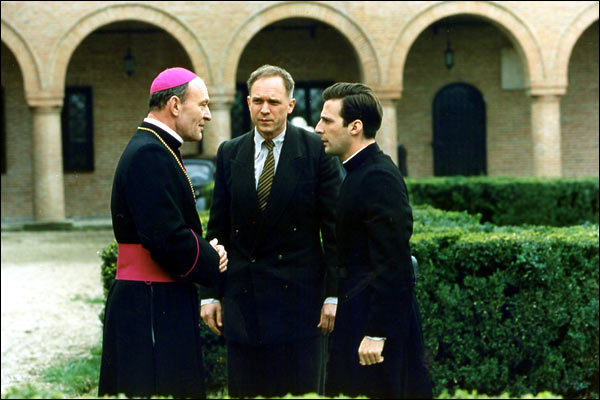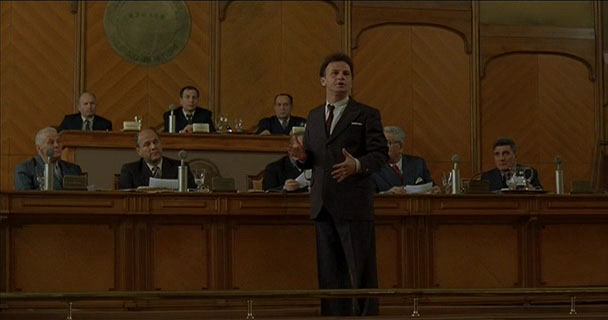From the March 14, 2003 Chicago Reader. — J.R.
Irreversible
* (Has redeeming facet)
Directed and written by Gaspar Noe
With Monica Bellucci, Vincent Cassel, Albert Dupontel, Jo Prestia, and Philippe Nahon
Amen.
** (Worth seeing)
Directed by Costa-Gavras
Written by Costa-Gavras and Jean-Claude Grumberg
With Ulrich Tukur, Mathieu Kassovitz, Ulrich Muhe, Michel Duchaussoy, and Fontana Ion Caramitru.

Why link an arty exploitation picture about rape, murder, and revenge with a sober adaptation of Rolf Hochhuth’s The Deputy, a 1960s German play about the failure of the Vatican to save Jewish lives during the Holocaust? One reason is to point out a critical difference between them. In Irreversible Gaspar Noe elects to show us everything — two faces being smashed to bloody messes, the heroine being raped and beaten for an agonizing ten minutes — while in Amen. (which played last week at the Music Box) Costa-Gavras shows his hero Kurt Gerstein (Ulrich Tukur), a newly commissioned SS lieutenant with a conscience, watching the gassing of Jews through a peephole with other officers but refuses to show us any part of what Gerstein sees.
The difference here concerns more than just etiquette. In the terms propounded by Claude Lanzmann’s Shoah (1985), it concerns ethics. Lanzmann’s 503-minute documentary about the Holocaust seeks to impart as much physical data about the death camps as it can gather from surviving participants and witnesses, but it doesn’t regard footage of death or torture as data that’s either ethically permissible or ethically useful. Amen., a docudrama rather than a documentary, is clearly guided by Shoah‘s example, asking us to reflect on the Holocaust and what made it possible rather than simply recoil from it.
Another important difference between the two films is that Amen. has so many facts to impart that its only concern when it comes to style and form appears to be what will allow the audience to absorb this information, whereas Irreversible is so formally and stylistically aggressive that this aspect overpowers what it has to say, which isn’t much. The formal aggression is apparent mainly in a succession of single shots lasting roughly ten minutes that moves backward in time, obliging the viewer to piece together the original chronology of events only gradually and somewhat haphazardly. The stylistic aggression consists largely of a wildly gyrating camera, turning in 360-degree vertical pans that often make it difficult to determine what’s going on (though during the rape the camera is mainly fixed, as it is during many of the subsequent scenes, at a party, on a Paris metro train, and in the lead couple’s bedroom after a bout of blissful sex). As a consequence the viewer is deliberately prevented from following the story directly in terms of time and space.
In spite of being stupid and odious, Irreversible is still interesting for the way it plays with the viewer’s nerves. I can’t bring myself to call it “worth seeing” for most people, but I also can’t deny that it’s made with a great deal of skill or that some of its ideological confusion can be learned from — as long as it’s recognized as confusion. In contrast, Amen. is worth seeing for its lucidity and for the historical information it imparts. As a work of cinema, it has a formal and stylistic interest that’s close to zero.
I’ve called Noe’s previous feature, I Stand Alone (1998), a masterpiece, and I’m not about to take that back. Yet I’m inclined to regard it as an accidental masterpiece — a masterpiece despite the declared intentions of its author, who wanted to call the picture France and whose reason for wanting to take us into the mind of a violent racist butcher who has sex with his mentally challenged daughter appears to be the same reason he wants us to witness murder and rape at such length and in such painful detail in Irreversible. These reasons are set down fairly succinctly, if not always clearly, in Irreversible‘s press book:
“Because time destroys everything
“Because some acts are irreparable
“Because man is an animal
“Because the desire for vengeance is a natural impulse
“Because most crimes remain unpunished
“Because the loss of a loved one destroys like lightning
“Because love is the source of life
“Because all history is written in sperm and blood
“Because in a good world
“Because premonitions do not alter the course of events
“Because time reveals everything
“The best and the worst.”
I consider I Stand Alone a masterpiece because of what it suggests about the xenophobia and panic of some of the French people who voted for Jean-Marie Le Pen, and because it forces me to share some of their anguish and understand some of their rage. But Noe’s view of what he’s doing goes far beyond this. I’m willing to concede that man is an animal (as opposed to, say, a vegetable or a mineral), that time reveals a lot (if not everything), and that premonitions don’t alter the course of events (if they did they wouldn’t be premonitions). But I can’t follow syntactically his sixth and ninth declarations (destroys what like lightning?), and I’m inclined to counter his other declarations by asserting that time doesn’t destroy everything, that the desire for vengeance isn’t necessarily a natural impulse, that love isn’t the only source of life, and that some histories are written in ink or celluloid.
But trying to take Gaspar Noe at his word gets you nowhere, because he doesn’t always seem aware of or even concerned about what he’s saying. (As John Powers recently pointed out in the LA Weekly, “Like David Lynch, Noe is drawn to things he doesn’t want to understand or control.”) He claims that the story of Irreversible is told backward, and most reviewers have taken that at face value. But as in the overrated and similarly antihumanist Memento, every sequence proceeds forward; it’s only the order of the sequences that’s backward. (To tell a story backward in cinematic terms requires the ingenuity of Kurt Vonnegut Jr., who in one of his novels describes planes sucking up fire from cities before flying backward to factories, where bombs are carefully extracted and disassembled so that the various parts can be processed and then buried in diverse locations, where they can never harm anyone again.) And this imprecision leads to other imprecisions, extending to the film’s supposedly backward credits at the beginning, where only some letters are printed backward.
So far I’ve been placing all the responsibility for Irreversible on Noe and none on his producers and cast. But the press book — which, in a cute ploy, recounts the film’s production and postproduction history in segments that also run backward — reveals at its end that Noe started out with an alternative exploitation concept: to use the real-life couple of Monica Bellucci and Vincent Cassel in “a joyous and provocative film” that would feature them having real sex together. The couple agreed to make a film with Noe but rejected the proposed sex — though it quickly became clear that they were willing to participate in simulated violence “even when Noe [affirmed] that he [wanted] to make a film more violent than Salo and Straw Dogs combined. As expected, simulated violence [posed] less of a problem than unsimulated sex.” At which point, apparently, producers had little trouble raising money for the film, even though there was no script and Noe wanted most of the dialogue to be improvised. We’re also told that the only censorship exercised by the film’s producers was to “conclusively” reject the use of the phrase “vengeance is man’s right” on the film’s poster.
Here we enter another realm of confusion. The film begins with its supposedly backward credits and a brief appearance by Philippe Nahon, the butcher of I Stand Alone (also the focus of Noe’s first film, Carne) — brought back like a presiding philosopher king to inform us and a friend of his that “time destroys everything.” We then see the arrest for murder of the two male leads, the heroine’s current and former lovers (Cassel and Albert Dupontel), in a gay S and M club called the Rectum, the cops spouting homophobic invective at them as they’re taken away. But the camera gyrates so wildly throughout this and the next few sequences that even though we get to witness the preceding violence, we have only a blurry sense of who the victim is.
Many reviews state that the victim is the gay rapist the heroes are looking for; many others say the wrong person gets bashed to death. I decided it wasn’t worth seeing the film again in an effort to figure it out. Yet I’m tempted to conclude that whatever Noe intended, in effect he’s saying “Vengeance is man’s right,” whether it’s meted out to the right person or the wrong one. The key issue seems to be what will attract world sales and bring in the customers.
It shouldn’t be surprising that contradictory interpretations of the film as a whole have also proliferated. The “joyous” ending of the blissful heterosexual couple (Bellucci and Cassel) enjoying each other’s company in the midst of strategically placed posters for Stanley Kubrick pictures (The Killing and 2001) and the heroine discovering that she’s pregnant can either be taken as straight or as parodic. (In the summer 2002 issue of Cinema Scope, Noah Cowen guardedly defends the film by opting for the latter, arguing that the “ridiculous, idealized notion of heterosexual reproduction…should be regarded [as the film’s true] object of horror.”) Whatever one decides, it becomes a rationalization either for Noe’s violence or for our willingness to tolerate it. If Irreversible has any value it lies in our pondering which form of rationalization we’re engaging in.
In her 1964 essay “Reflections on The Deputy,” in the collection Against Interpretation, Susan Sontag argued that just “as it would be obtuse to refuse to evaluate the [Adolf] Eichmann trial as a public work of art, it would be frivolous to judge The Deputy simply as a work of art.” Perhaps she’d formulate her point differently today, but I believe it remains sound: to take the Eichmann trial as “a public work of art” and to take The Deputy as something other than a work of art means to analyze aspects of their social functions and meanings, and there’s surely nothing wrong with that. For we’re often confused about what we mean by art as well as by entertainment; to call both Amen. and Irreversible works of art as well as pieces of entertainment is certainly accurate, but since we’re usually incapable of using either term nonjudgmentally, our ethics often wind up affecting our aesthetics, and sometimes vice versa.
In the immediate aftermath of the May 1968 student riots in France, when critics at Cahiers du Cinema were attempting to hammer out new models for political filmmaking, the popular leftist but commercial films of Costa-Gavras were singled out as bad models. Even when they were grudgingly defended, they were valued mainly as instructive errors. “It is not possible,” wrote Jean-Louis Comolli in 1970, “in the name of theoretical purity or rigor, simply to dismiss as totally worthless the mass of films for which The Confession and Z might (and do) serve as models. These films are certainly not the site of any cinematographic work, any signifying practice capable of subverting the aesthetic-cultural norms of the dominant ideology; but for that very reason they stand at the center of the ideological stage and participate massively in the general ideological confusion, playing the part [for] a great many spectators and virtually all the critics of authentically political films.” By contrast, intellectual critics in the U.S. such as Pauline Kael were defending these Costa-Gavras films about political assassination (Z) and the Stalin show trials (The Confession) with fewer compunctions, though even Kael admitted to misgivings: “The techniques of melodrama are not those of art,” she wrote in her review of Z — a rather sweeping claim that would also seem to rule out Hamlet and favorites of hers such as The Godfather — “but if we accept them when they’re used on trivial, fabricated stories (robberies, spy rings, etc.) merely to excite us, how can we reject them when the filmmakers attempt to use them to expose social evils and to dramatize political issues?”
Apart from the incident that opens Amen. — a Jewish man enters a League of Nations gathering in Geneva in 1943 with leaflets and shoots himself after declaring, “I see no other way of reaching people’s hearts” (apparently based on the real-life suicide of Szmul Zygielbojm at a conference held that year in Bermuda) — there’s little in the picture that qualifies as melodramatic. The principal emphasis is on the failed efforts of Kurt Gerstein to expose the extermination of Jews to the outside world (while attempting through various ruses to slow the process down) and the simultaneous failure of Father Riccardo Fontana (Mathieu Kassovitz) — a young Jesuit priest whose father has close ties to the pope — to persuade the Vatican to take steps on behalf of the Jews. Though the film’s plot certainly isn’t devoid of suspense, its main focus is on what we know failed to happen, making it the reverse of Schindler’s List.
Gerstein was a real person — a prestigious chemist who discovered that the Zyklon B pellets he developed to disinfect soldiers’ drinking water was being used to gas thousands of Jews — while Father Riccardo is a fictional character designed to represent all the priests who fought against the Nazi persecution of Jews. The parallel stories of the two are gracefully intercut, periodically coming together once they become acquainted. For me, Gerstein’s story is more compelling — not only because it’s closer to the literal truth, but because it dramatizes the difficulty of someone at the center of a horror trying to stop the process. (After being ordered to furnish enough Zyklon B to kill “12 million units,” he tries to recall all the shipments of the crystals, claiming they’re defective and too dangerous to handle — only to be told that they do “work,” though badly.) And as the closing scenes make clear, part of the film’s mission is to examine how imperfectly war crimes often are assessed after the fact. Arrested as a war criminal in April 1945, the real-life Gerstein was found dead in his cell less than three months later — the cause of death is unknown — and wasn’t cleared of all charges for 20 years. The film’s villain — an SS leader known as “the doctor,” played with grim effectiveness by Ulrich Muhe — is helped in his escape to Argentina by the Vatican.
I would argue that there are only two basic criteria by which a film like Amen. can be judged: whether the facts it imparts are true and, if true, whether they’re useful. Sontag wrote in 1964, “Unlike the plays of Shakespeare or Schiller or Brecht, Hochhuth’s play stands or falls by its fidelity to the complete historical truth,” and I assume the truth in this context is defined at least partially by the uses it can be put to. Hochhuth’s play clearly has been trimmed by Costa-Gavras and his cowriter, Jean-Claude Grumberg (the original usually runs at least six hours, the film only 130 minutes), and it’s probably been given a cleaner narrative line. Not knowing the original, I can only express my inclination to believe that the adaptation is serious rather than cynical, and that the most significant facts in Amen. are both true and worth taking seriously.
But I still have to ask: Worth taking seriously by whom? For what reasons? In what contexts? Is the value of The Deputy in 1964 identical to its value in 2003? In the press book for Amen., an interviewer poses a question to Costa-Gavras and Grumberg “which could be asked today about all the tragedies in the world, thus proving that the ethics of the film concern us all: who knew and what was done?” Costa-Gavras replies, “Everybody knew.” Grumberg adds, “The camps were the climax of a string of acceptances. Millions of people around the world giving in and accepting. Indifference is just a softer version of complicity.” And Costa-Gavras adds to this, “The indifference is still there. It did not start with the camps, nor did it end with the war. It did not grow during the war either: what became more serious and unbearable was the events. I do not know what — among all the events we are living through today — will seem as a monstrous, inhuman attitude to our grandchildren. Look at the indifference with which we are letting the African continent die. Our passivity is a crime in itself.”
But let me bring another voice into the discussion, that of German film critic Olaf Moller. When I recently mentioned in passing in an E-mail that I was writing about Amen. and Irreversible together, he wrote back that he found this juxtaposition interesting albeit “somewhat sickening, but so is cinema’s reality right now.” He went on to tell me that he preferred Irreversible, explaining his dislike of Amen. by saying, “I have to admit that, at least for me, the excess of opinion and Betroffenheit (there is, judging by my dictionary, no English equivalent: it means something like embarrassed, awkward, seriously guilt-ridden silence) is far worse than Noe’s formalist lizard-choking: At least there’s something like meaning in Noe’s style, albeit a politically, well, less desirable one….Whereas CG’s howling is nothing [but] bourgeois self-congratulation, jerking off to a feeling of moral superiority.”
For me, Betroffenheit is a handy new term, though I find it more relevant to Irreversible, at least in the U.S., than to Amen. For Moller, living in a country that’s been dealing with Betroffenheit about the Holocaust for almost half a century and is today essentially pacifist, a film like Amen. is bound to offer fewer lessons than it would in the U.S., where indifference to atrocities is arguably a more pressing issue. Here Betroffenheit is more likely to accompany the crossing of explicitness thresholds in the name of free speech and democracy: some part of us is apt to approve of the boldness of an Irreversible even as we choke on its implications. Because of this moral confusion and the embarrassed, guilt-ridden silence that often accompanies it, I would argue that Irreversible is the film that has fewer lessons for Americans, whatever its interest as an experiment and as a stylistic exercise.
Noe’s film is more fashionable — and getting much more media attention — than Amen. on both sides of the Atlantic because of its “edginess,” but that doesn’t necessarily mean we can learn more from it. I would argue that its status as a fashion statement discourages us from learning much from it. The envelope it pushes is new only in the degree of its ugly explicitness, not in the broaching of new subject matter. Amen. shows us nothing of the atrocities it deals with, but it still has a lot to say. This makes it the precise reverse of Irreversible, which ultimately speaks about nothing but shows us everything.








